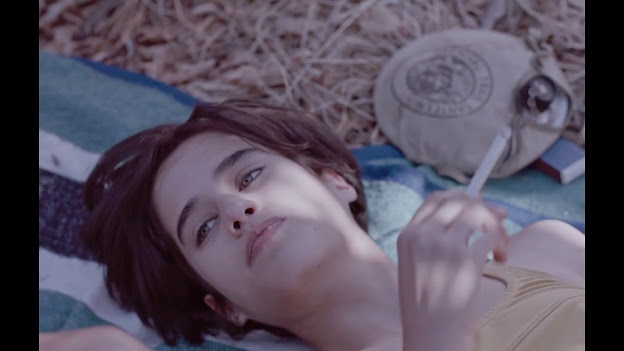 |
| Demian Hernández in Too Late to Die Young |
Cast: Demian Hernández, Antar Machado, Magdalena Tótoro, Matías Oviedo, Andrés Aliaga, Antonia Zegers, Mercedes Mujica, Gabriel Cañas, Alejandro Goic, Eyal Meyer, Cecilia Rainero, Michael Silva, Luciano Jadrievich, Pablo Giesen, Millantú Hilbert, Alejandro Garrós. Screenplay: Domingo Sotomayor. Cinematography: Inti Briones. Production design: Estefania Larrain. Film editing: Catalina Marín Duarte.
Too Late to Die Young tosses viewers into an unfamiliar place with unfamiliar people and leaves us to figure out where and who they are, and why they're doing things. It's usual for movies to do this, of course, and we've all learned to follow the clues that lead us to the answers. But Dominga Sotomayor doesn't make it easy for us, especially because there are so many characters that it takes us time to figure out which one is the center of the film. In this case, it's Sofia (Demian Hernández), a teenage girl struggling to find her way into womanhood, and that's a situation familiar enough to give us some grounding. Eventually, we realize, if we're patient and attentive, that the group of people around Sofia are Chilean families who are fleeing urban life (and politics) in the city of Santiago, the lights of which we can see from their mountainside retreat, a kind of latter-day hippie commune. As the sometimes feckless adults do their thing, Sofia develops an infatuation with the somewhat older Ignacio (Matías Oviedo), as meanwhile a boy her own age, Lucas (Antar Machado), is falling for her. Sofia's father and mother have separated, and she has come to this new community with him but longs to live with her mother. She expects the mother to visit them for the New Year's celebration but is crushed when she doesn't arrive. The other character on whom the film focuses is young Clara Magdalena Tótoro), who gets separated from her dog, Frida, finds her again (perhaps), but loses her once more. It's a kind of metaphor for the unstable relationships that are the core of the film, which has been seen as a commentary on the instability of Chilean politics and society after the fall of Pinochet. The New Year's party becomes a central focus of the film, and it precipitates the film's denouement by sparking a forest fire that destroys the encampment. It's a movie full of well-observed moments and fine performances by its mostly young cast, especially Hernández, who transitioned to male after the film's shooting ended.